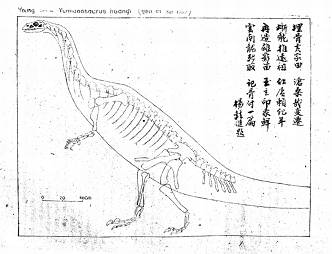Dinosaur poetry
A few days ago, Metafilter user brundlefly posted a link to the Skeletal Drawing blog's three-part series on the history of skeletal drawings. As I was reading through "Part 2 - Bone Wars to the 1950's", I came across this picture:

A Yunnanosaurus, drawn by its discoverer Yang Zhongjian 楊鍾建 (a.k.a. C. C. Young). And with a poem attached! Here's what I make of it (plus some updates from comments):
埋骨亥家田 滄桑幾変遷
蜥龍推遠祖 紅層賴紀年
再造雄影留 玉立印象鮮
雲南龍掘取 記骨付一遍
楊鍾建題Buried bones beneath homes and fieldsSkeletons buried beneath the fields
Oceans to mulberry orchards, how the ages pass
The lizard considers its far ancestor
Red layers let us count the years
Reconstructed, its mighty shape remains
Graceful its form and vivid to see
Yunnanosaurus, now unearthed:
A tale written in bones
—Yang Zhongjian
I've refrained from adding [?] after every piece of guesswork in the above, but don't let that fool you: I'm well out of my depth here. (For instance, I'm not even convinced that third character in line one is really 実, and I'm not sure even if so just what that would mean. It was probably 亥, "short" for 骸!) Sinological expertise welcome.
![[No-sword]](http://no-sword.jp/images/site/no-sword_banner.jpg)



無名酒:
The strokes don't look like 実 to me, more like 亥, maybe short for 骸?